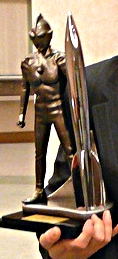Voting Ends for This Year's Hugo Awards
 Today's the last day to vote on the 2008 Hugo Awards, which will be given out at the World Science Fiction Convention next month in Denver. I joined the convention as a supporting member last fall to vote for the first time on the awards, which began in 1955 and have become the most coveted prize in science fiction.
Today's the last day to vote on the 2008 Hugo Awards, which will be given out at the World Science Fiction Convention next month in Denver. I joined the convention as a supporting member last fall to vote for the first time on the awards, which began in 1955 and have become the most coveted prize in science fiction.
In April, the Hugo nominees were announced. All of the nominees in several categories can be read for free online, including short stories, novellas, novelettes and fanzines. Four of the five best novel nominees were privately shared with voters as ebooks.
I won't disclose my votes until after the ceremony (if at all). I skipped most categories because I hadn't read enough of the nominees, but I did read all of the Best Short Story choices. Three of the five are terrific stories that were hard to rank from first to third. The other two not so much; I ranked them lower than "No Award."
The nominees, in alphabetical order:
- "A Small Room in Koboldtown" by Michael Swanwick, from the April/May 2007 issue of Asimov's Science Fiction
- "Distant Replay" by Mike Resnick, from the April/May 2007 Asimov's
- "Last Contact" by Stephen Baxter, from The Solaris Book of New Science Fiction 2007
- "Tideline" by Elizabeth Bear, from the June 2007 Asimov's
- "Who's Afraid of Wolf 359?" by Ken MacLeod, from The New Space Opera
If you'd like to vote in the next Hugos, become an attending or supporting member of the WorldCon convention for Montreal in 2009. I got carried away and have already joined Australia in 2010 and Seattle in 2011, though they could still get beaten out by another site.
Credit: The photo of a 2007 Hugo Award statue was derived from a photo taken by Cory Doctorow and is available under a Creative Commons license.
How to Deal With Obnoxious Blog Comments
 Matt Asay, an executive who writes CNET's Open Road open source blog, got so mad at commenters on his site yesterday that he began hunting them down:
Matt Asay, an executive who writes CNET's Open Road open source blog, got so mad at commenters on his site yesterday that he began hunting them down:
... most people are not jerks. They just become losers when cloaked in anonymity. They say things they'd never say if confronted with the people they flame on discussion boards, in comments sections, etc. They're probably nice people "in real life." It's just on the web that they let it all hang out, to the detriment of the web and intelligent discussion.
Take the comments to one of my recent posts. The first is led off by "h3h" who apparently has no sense of humor (completely missing my point in the post), but can't leave it at that, then going on to lob ad hominems into his "argument."
"H3h" turns out to be Brad Fults. Judging from his Flickr feed and Twitter feed, he's probably an OK guy. He happens to be wrong in the way he chose to comment on this blog, but he's probably a well-intentioned person, normally.
Asay doesn't seem to understand the concept of anonymity. Fults' comments on CNET include a link to his web site, which contains his name and is presumably how Asay found it.
Anyone who reads Workbench knows that I get my fair share of anonymous abuse, particularly from people who read my Target story and let me know I'm a bad parent. That never gets old.
If you publish on the web and accept user comments, you're going to be a punching bag for a steady procession of dillweeds. Your choices are to stop taking comments, pick them off one by one like Asay, or just keep telling yourself you're a beautiful snowflake and soldier through it.
Credit: The photo of Matt Asay was taken by Ilya Schurov of Computerra Weekly and is available under a Creative Commons license.
Tropical Storm Bertha Forms in East Atlantic
Tropical Storm Bertha formed in the Atlantic today at a record-setting location that suggests an active hurricane season, meteorologist Jeff Masters blogs:
Today's formation of Bertha at 25 degrees West longitude is the farthest east a tropical storm has ever formed in the Atlantic so early in the season. It is also the farthest east a tropical storm has formed in the month of July. Reliable records of Eastern Atlantic storms go back to 1967, the beginning of the geostationary satellite era.
Is the formation of Bertha a harbinger of an active hurricane season?
Probably. According the the Hurricane FAQ, "as shown in (Goldenberg 2000), if one looks only at the June-July Atlantic tropical storms and hurricanes occurring south of 22 degrees N and east of 77 degrees W (the eastern portion of the Main Development Region [MDR] for Atlantic hurricanes), there is a strong association with activity for the remainder of the year."
Current models forecast a path for Bertha that will curve north and miss the U.S., but there's not a lot of confidence in that prediction yet.
Buscarlos Sonidos Magicos de Ecuador
Liking this song exposes me to "you know how I know you're gay?" ridicule, but every time I hear "Ecuador" by Sash I crank the knob up to 11 and reinsert "Escuchame!" back into my vocabulary.
Setting Up Westell Modems with Linksys WRT54G Routers
I connect to my high-speed DSL Internet service using a Westell WireSpeed modem that's hooked up to a Linksys WRT54G router. Last week a power outage hosed the settings on the modem and router, which knocked me offline until I figured out the proper configuration. I was so desperate at one point that I called my ISP's outsourced tech support, speaking for 15 minutes to a pleasant wage slave in Bangalore or another distant port o' call center who could not have been less helpful.
 For the help of others in my predicament, and myself in the future when I forget how to do this again, I'm documenting how to configure a Westell modem to work with a WRT54G router.
For the help of others in my predicament, and myself in the future when I forget how to do this again, I'm documenting how to configure a Westell modem to work with a WRT54G router.
First, connect a computer directly to the Westell modem using an Ethernet cable and see if you can browse the web. If you can, this confirms that your Internet connection is fine and your modem/router configuration is the most likely cause of the problem.
While the modem is connected, load the address http://192.168.1.254 in your browser, which opens a web application in the modem that enables it to be configured. Choose Expert Mode from the main menu, which adds options to the menu, then choose the Configure Connection option.
Westell modems are set up by default to act as their own router. This is ungood if you have another router, because they conflict with each other and neither works properly. When you are connecting the modem to a router, the modem must be set to "Bridged Ethernet" mode to disable its routing capabilities. This option can be selected in the Protocol drop-down box. After setting the modem to Bridged Ethernet, click Save and Restart Connection.
Next, disconnect the computer from the modem and turn the router and computer off, which for the router requires pulling the cord out of the back. Once this is done, plug the modem into the router with an Ethernet cable while the router's power is still off. Wait 10 Mississippis, then turn the router and computer back on in that order.
Load the address http://192.168.1.1 in your browser to open the router's web configuration application. This application requires a username and password. If you've never set one up, leave the username blank and use the default password "admin". The Basic Setup form is displayed. Choose the Internet Connection Type PPPoE (Point-to-Point Protocol over Ethernet), then click Save Settings.
To see if it works, choose the Status tab to display information about your connection. If Login Status is "Connected", the router's connecting to the Internet successfully through the modem. If not, click the Connect button.
(At this point you're done, but if you haven't set up router and wireless password, anyone can change your configuration and use your wireless Internet connection. Click the Administration tab to set a router username and password. Click the Wireless tab and the Wireless Security link to restrict wireless access.)
Broadband Reports has more information on configuring Westell modems and Linksys routers.
Life on the Streets of St. Augustine
A blog in St. Augustine, Art in the Market, is published by street artists who are tired of being driven away from the city's Old Town district by police. Ten years ago, the thousands of tourists who walked up and down St. George Street in Old Town would see a motley assortment of musicians, artists and street performers. One of our favorites was Sterling the Silver Man, a guy covered in glittery spray paint who combined robotic movements with the occasional water gun sneak attack on passers-by. My kids loved it.
 In the late '90s, shopkeepers on the street decided that these folks were bad for business, so they got the St. Augustine city council to pass ordinances that make it illegal for them to work on the street. This sucked most of the charm right out of the place, so we visit much less often.
In the late '90s, shopkeepers on the street decided that these folks were bad for business, so they got the St. Augustine city council to pass ordinances that make it illegal for them to work on the street. This sucked most of the charm right out of the place, so we visit much less often.
Today on Art in the Market, they tell a story of another side of street life in the nation's oldest city -- the death of John Lynch, a homeless alcoholic who was a fixture in the area:
When tourists or residents complained about the "bums" in the Plaza it was many times in reference to John Lynch. Whatever sent Mr. Lynch on the road to broken down alcoholism, we'll never know. He was usually in an extremely foul mood. Life had battered him apparently and he escaped into the bottle. He had over 32 citations and a number of incarcerations from" open container" violations to aggravated battery(drunken disputes). ...
If he had been dry for awhile (jail time) his appearance changed to a tall, distinguished, white haired 63 year old gent who could be mistaken for the head of the Rotary. This change lasted until he got a hold on another bottle.
I'd be lying if I said panhandlers and homeless people in this part of Florida are a welcome sight. Some of them are young, able-bodied and fairly intimidating, and I think the last time I gave one money was years ago in Fort Worth, Texas, when a guy wouldn't let me pass on a deserted street. But I appreciate the fact that a local blogger's telling stories that would otherwise go untold.
Credit: The photo of a street musician on St. George Street was taken by Bill Frazzetto and is available under a Creative Commons license.
AP Settles Dispute with Drudge Retort
Late Thursday night, AP issued the following statement after a day-long discussion of the DMCA takedowns issued to the Drudge Retort that reached all the way up to the company's top management:
In response to questions about the use of Associated Press content on the Drudge Retort web site, the AP was able to provide additional information to the operator of the site, Rogers Cadenhead, on Thursday. That information was aimed at enabling Mr. Cadenhead to bring the contributed content on his site into conformance with the policy he earlier set for his contributors. Both parties consider the matter closed.
In addition, the AP has had a constructive exchange of views this week with a number of interested parties in the blogging community about the relationship between news providers and bloggers and that dialogue will continue. The resolution of this matter illustrates that the interests of bloggers can be served while still respecting the intellectual property rights of news providers.
I'm glad that my personal legal dispute with the AP is resolved, thanks to the help of the Media Bloggers Association, but it does nothing to resolve the larger conflict between how AP interprets fair use and how thousands of people are sharing news on the web. You could probably guess that by the lack of detail in AP's statement.
I spent around two hours yesterday talking to AP attorneys about their specific objections to the user blog entries in dispute, going line by line through the text to pinpoint exactly where they have intellectual property concerns in the short excerpts that were posted. I won't reveal the details of this discussion until AP releases the guidelines for bloggers that it promised on Monday.
On a social news site that's still manageable in size, like the 8,500-member Drudge Retort, it's possible to steer bloggers away from potential conflicts with media organizations by working directly with users. But 25 million people visited a social news site last month, and thousands of people are sharing news links in a way that's in direct conflict with AP's interpretation of fair use regarding the headlines and leads of its articles.
If AP's guidelines end up like the ones they shared with me, we're headed for a Napster-style battle on the issue of fair use.
When it appeared that I might end up in court on this issue, I got offers of help from the Electronic Frontier Foundation, Public Citizen and the Stanford Fair Use Project. My attorney Wade Duchene and I were already working up the victory speech to deliver on the steps of the Supreme Court in the landmark First Amendment decision AP v. Me (Justices Stevens, Ginsburg, Breyer, Souter, Kennedy, Lessig, Tribe and Clinton concurring).
I think AP and other media organizations should focus on how to encourage bloggers to link their stories in the manner they like, rather than hoping their lawyers can rebottle the genie of social news. Given the publicity of this dispute, the first blogger sued for excerpting a news story will have the best pro bono legal representation that massive press attention can buy.
Although AP will be releasing guidelines, I don't think the news service will be able to concede any ground to the blogosphere. AP sells headline and lead-only services to customers. Asking the company to concede there's a way people can share this information for free is like asking the RIAA to pick its favorite file-sharing client.
If an expansive view of fair use is to remain in place, it's incumbent upon bloggers and our $500-an-hour friends in the legal community to define our own guidelines and fight for them. If we don't, big media companies will eventually define them for us, just as they've gotten the Digital Millenium Copyright Act and Copyright Term Extension Act passed in Congress.
I have learned that the Drudge Retort popped up on AP's radar through its use of Attributor technology to find potential cases of copyright infringement, as K.C. Jones reported in InformationWeek:
Attributor launched last year, with company representatives saying they would identify and "fingerprint" chunks of content from more than 10 billion pages on the Internet. The company provides a service to media outlets and other content creators to track how their content is reused online and whether the user has authorization to reproduce the material.
"Our agreement with Attributor will enable AP to safeguard its investment in creating and distributing news reports, while assuring licensees that unauthorized use will not diminish the value of their licenses," AP general counsel Srinandan Kasi explained in the announcement. "These services are part of the next-generation licensing and enforcement services we plan to provide to our global network of members and subscribers."
Earlier this year, Attributor told its customers that when a case might be fair use, it's better to ask for credit than to file a DMCA takedown:
No one wins when a DMCA notice is sent. First, unless you have an open and shut case, a DMCA notice can be a PR risk for the DMCA sender. Next, the site hosting the content has to deliver the bad news to its user putting them in an unfavorable spot. Finally, consumers lose overall because the result of content removal is one less place to find quality content. ...
You can't send a DMCA notice if it's Fair Use -- and Fair Use is usually not a black and white situation. The fairness of asking for a link is indisputable.
As a newspaper reader since age 8 and the spouse of an investigative reporter, I want the media to keep making enough money to afford the expensive and essential practice of journalism. I sure as hell don't want to do all that reporting myself.
If AP's core business is to report the news, blogs and social news sites send millions of people to its articles every day. Retort users have posted 41,000 links to news stories in the last four years, each link sending from 1,000 to 5,000 readers directly to a media site to read the article.
If its core business is to repackage the news, they're in as much trouble as every other middleman on the web.
Related links:
- New York Times: A.P. Asserts Tough (and Still Secret) View of Copyright on Blogs

